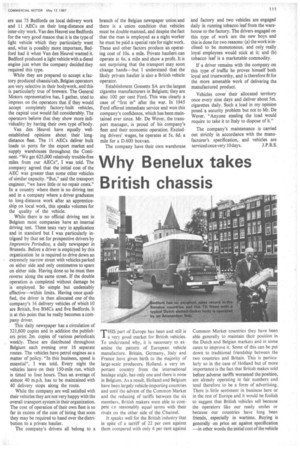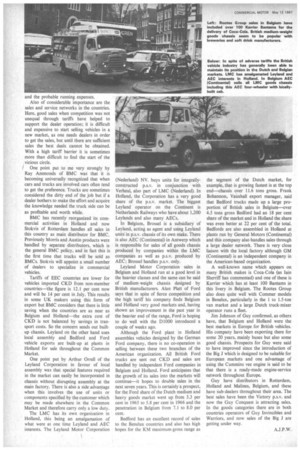Why Benelux takes British chassis
Page 113

Page 114

If you've noticed an error in this article please click here to report it so we can fix it.
rr'HIS part of Europe has been and still is a very good market for British vehicles. To understand why, it is necessary to examine the pattern of European vehicle manufacture. Britain, Germany, Italy and France have given birth to the majority of large-scale producers. Holland, a very important country from the international haulage angle, has only one and there is none in Belgium. As a result, Holland and Belgium have been largely vehicle-importing countries and until the advent of the Common Market and the reducing of tariffs between the six members, British makers were able to compete cn reasonably equal terms with their rivals on the other side of the Channel.
It speaks well for the British industry that in spite of a tarriff of 22 per cent against them compared with only 4 per cent against Common Market countries they have been able generally to maintain their position in the Dutch and Belgian markets and in some cases to improve it. Some of this can be put down to traditional friendship between the two countries and Britain. This is particularly so in the case of Holland but of more importance is the fact that British makes sold before adverse tariffs worsened the position, are already operating in fair numbers and tend therefore to be a form of advertising. There is little sentiment in business here or in the rest of Europe and it would be foolish to suggest that British vehicles sell because the operators like our ready smiles or because our countries have long been friends, especially in wartime. Buying is generally on price set against specification —in other words the initial cost of the vehicle and the probable running expenses.
Also of considerable importance are the sales and service networks in the countries. Here, good sales when competition was not unequal through tariffs have helped to support the dealer operation; it is difficult and expensive to start selling vehicles in a new market, as one needs dealers in order to get the sales, but until there are sufficient sales the best deals cannot be obtained. With a high tariff barrier it is sometimes more than difficult to find the start of the vicious circle.
One point put to me very strongly by Ray Ammonds of BMC was that it is becoming universally recognized that when cars and trucks are involved cars often tend to get the preference. Trucks are sometimes considered the dirty end of the job but if a dealer bothers to make the effort and acquire the knowledge needed the truck side can be as profitable and worth while.
BMC has recently reorganized its commercial activities in Holland and now Stokvis of Rotterdam handles all sales in this country as main distributor for BMC. Previously Morris and Austin products were handled by separate distributors, which is the general BMC policy, and in fact this is the first time that trucks will be sold as BMCs. Stokvis will appoint a small number of dealers to specialize in commercial vehicles.
Tariffs of EEC countries are lower for vehicles imported CKD from non-member countriesthe figure is 12.1 per cent now and will be 14 per cent in July. This results in some UK makers using this form of export but BMC considers that there is little saving when the countries are as near as Belgium and Holland the extra cost of CKD is not balanced by savings in transport costs. So the concern sends out builtup chassis. Leyland on the other hand uses local assembly and Bedford and Ford vehicle exports are built-up at plants in Holland for sale throughout the Common Market.
One point put by Arthur Orrell of the Leyland Corporation in favour of local assembly was that special features required in the market can easily be incorporated in chassis without disrupting assembly at the main factory. There is also a side advantage when this involves the use of units or components specified by the customer which may be made elsewhere in the Common Market and therefore carry only a low duty.
The LMC has its own organization in Holland, this being an amalgamation of what were at one time Leyland and AEC interests. The Leyland Motor Corporation (Nederland) NV. buys units for integrallyconstructed p.s.v. in conjunction with Verheul, also part of LMC (Nederland). In Holland, the Corporation has a very good share of the p.s.v. market. The biggest Leyland operator on the Continent is Netherlands Railways who have about 1,200 Leylands and also many AECs.
In Belgium, Brossel is a subsidiary of Leyland, acting as agent and using Leyland units in p.s.v. chassis of its own make. There is also AEC (Continental) in Antwerp which is responsible for sales of all goods chassis produced by companies within the LMC companies as well as p.s.v. produced by AEC: Brossel handles p.s.v. only.
Leyland Motor Corporation sales in Belgium and Holland run at a good level in the heavier classes and the same can be said of medium-weight chassis designed by British manufacturers. Alan Platt of Ford says that in spite of fierce competition and the high tariff his company finds Belgium and Holland very good markets and, having shown an improvement in the past year in the heavier end of the range, Ford is hoping to do well with the D1000 introduced a couple of weeks ago.
Although the Ford plant in Holland assembles vehicles designed by the German Ford company, there is no co-operation in selling between these two branches of the American organization. All British Ford trucks are sent out CKD and sales are handled by independent Ford companies in Belgium and Holland. Ford anticipates that the growth of its sales into the markets will continue—it hopes to double sales in the next seven years. This is certainly a prospect, for the Ford share of the Dutch medium and heavy goods market went up from 3.3 per cent in 1965 to 5.8 per cent in 1966 and the penetration in Belgium from 7.1 to 8.0 per cent.
Bedford has an excellent record of sales to the Benelux countries and also has high hopes for the KM maximum gross range as the segment of the Dutch market, for example, that is growing fastest is at the top end—chassis over 11.6 tons gross. Frank Bohannon, Vauxhall export manager, said that Bedford trucks made up a large proportion of British sales in Belgium—over 4.5 tons gross Bedford had an 18 per cent share of the market and in Holland the share was even better at 22 per cent of the total. Bedfords are also assembled in Holland at plants run by General Motors (Continental) and this company also handles sales through a large dealer network. There is very close liaison with the local factory although GM (Continental) is an independent company in the American-based organization.
A well-known name which appears on many British makes is Coca-Cola (as lain Sherriff has commented) and one of these is Karrier which has at least 100 Bantams in this livery in Belgium. The Rootes Group also does quite well with Commer models in Benelux, particularly in the 1 to 1.5-ton van market and a large Dutch truck-mixer operator runs a fleet. , Jim Johnson of Guy confirmed, as others have, that Belgium and Holland were the best markets in Europe for British vehicles. His company have been exporting there for some 20 years, mainly buses but also some good chassis. Prospects for Guy were said to have improved since the introduction of the Big J which is designed to be suitable for European markets and one advantage of using the Cummins vee engine is said to be that there is a ready-made engine-service network throughout Europe.
Guy have distributors in Rotterdam, Holland and Malines, Belgium, and these have sub-dealers throughout their area. The best sales have been the Victory p.s.v. and now the Guy Conquest is attracting sales. In the goods categories there are in both countries operators of Guy Invincibles and Warriors, and now sales of the Big J are getting under way.
A.J.P.W.
















































































































































































































































